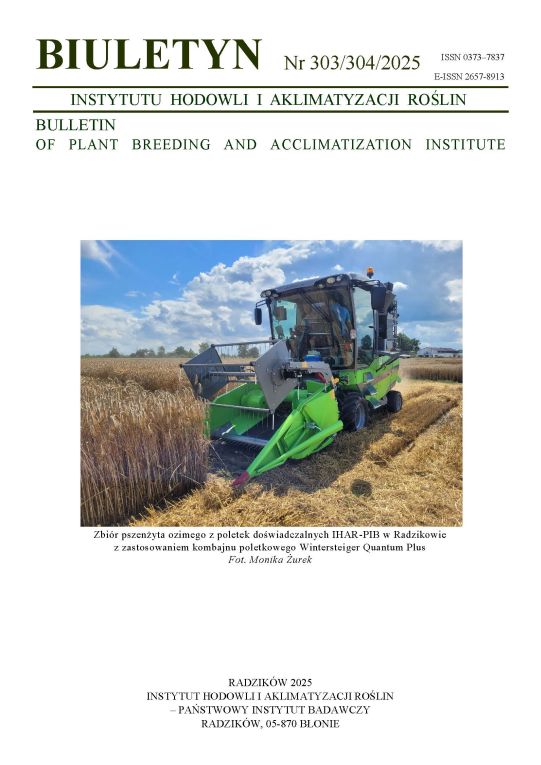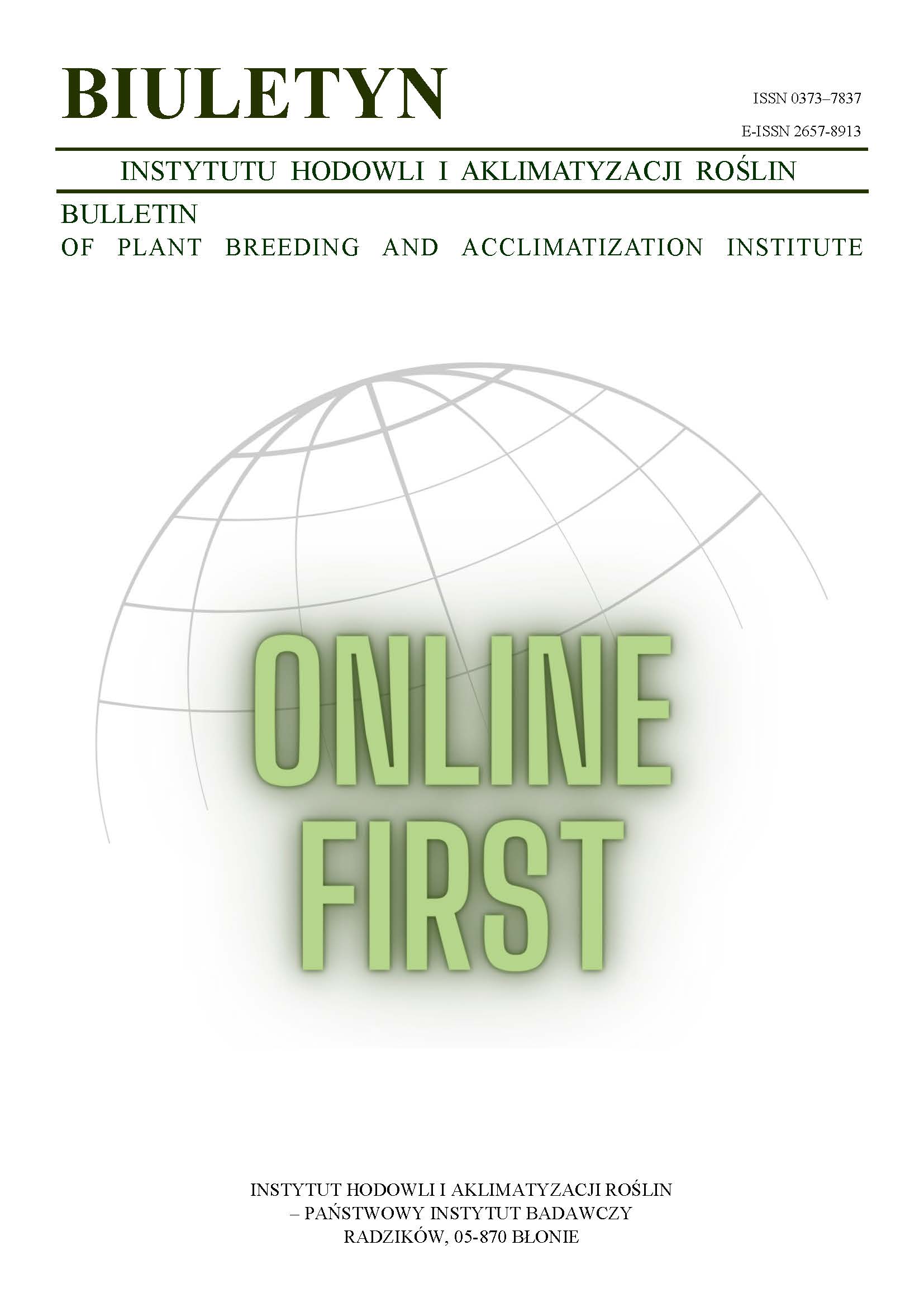The usefulness of NegFry decision support system in potato protection against late blight under different meteorological conditions
Józefa Kapsa
j.kapsa@ihar.edu.plInstytut Hodowli i Aklimatyzacji Roślin w Radzikowie, Zakład Nasiennictwa i Ochrony Ziemniaka w Boninie (Poland)
Edward Bernat
Instytut Hodowli i Aklimatyzacji Roślin w Radzikowie, Zakład Nasiennictwa i Ochrony Ziemniaka w Boninie (Poland)
Małgorzata Kasprzak
Instytut Meteorologii i Gospodarki Wodnej, Poznań (Poland)
Abstract
Chemical protection against potato late blight can either comprise the intensive usage of fungicides starting from potato emergence or base as sustainable protection, on forecasting of pathogen occurrence and utilize decision support systems that can help to predict the date of disease outbreak to determine the timing of first treatment. Field experiments on usefulness of NegFry decision support system in potato protection against late blight in northern part of Poland were conducted at the Plant Breeding and Acclimatization Institute, Bonin, in the years 2002–2004. The effectiveness of different potato protection systems was compared. Under Bonin climatic conditions, the NegFry system recommended the first spray 0–34 days before the late blight was found at the trial site. Protection performed according to the NegFry indications resulted both in control of late blight and in reduction of a number of fungicide treatments compared to the routine model.
Keywords:
NegFry, potato, late blight, protectionReferences
Fry W. E. 1978. Quantification of general resistance of potato cultivars and fungicide effects for integrated control of potato late blight. Phytopathology 67: 415 — 420.
DOI: https://doi.org/10.1094/Phyto-67-415
Google Scholar
Fry W. E. 1994. Role of early and late blight suppression in potato pest management. In: Advances in potato pest biology and management. G. W. Zehnder, M. L. Powelson, R. K. Jansson, K. V. Raman. The American Phytopathology Society, St. Paul, Minnesota, USA: 166 — 177.
Google Scholar
Fry W. E., Apple A. E., Bruhn J. A. 1983. Evaluation of potato late blight forecasts modified to incorporate host resistance and fungicide weathering. Phytopathology 73: 1054 — 1059.
DOI: https://doi.org/10.1094/Phyto-73-1054
Google Scholar
Gunn J. S. 1990. Crop protection handbook — potatoes. British Crop Protection Council, UK: 192 s.
Google Scholar
Hansen J. G. 1993. The use of meteorological data for potato late blight forecasting in Denmark. In: Workshop on Computer-based DSS on Crop Protection Parma, Italy, 23-26 November 1993. Secher B. J. M., Rossi V., Battilani P. (eds.). Danish Institute of Plant and Soil Science. SP Report no 7: 183 — 193.
Google Scholar
Hansen J. G., Anderson B., Hermansen A. 1995. NEGFRY — A system for scheduling chemical control of late blight in potatoes. In: Phytophthora 150. Dowley L. J., Bannon E., Cooke L. R., Keane T., O’Sulivan E. (eds.). Dublin, Ireland: Boole: 201 — 208.
Google Scholar
Hansen J. G., Kleinhenz B., Jorg E., Wander J. G. N., Spits H. G., Dowley L. J., Rauscher E., Michelante D., Dubois L., Steenblock T. 2002. Results of validation trials of Phytophthora DSSs in Europe, 2001. PPO-Special Report 2 no. 8. (2002). Proc. 6th Workshop of a European network for development of an integrated control strategy of potato late blight. Edinburgh, Scotland, 26–30 September 2001: 231 — 242.
Google Scholar
Hoffman G. M., Schmutterer H. O. 1983. Parasitäre Krankheiten und Schädlinge an landwirtschaftlichen Kulturpflanzen. Verlag Eugen Ulmer. Stuttgart.
Google Scholar
Kapsa J. 2004. Zmiany stanu zagrożenia i ochrony plantacji ziemniaka przed zarazą (P.infestans) w Polsce na tle krajów europejskich. Progress Plant Protection. Postępy w Ochronie Roślin, Vol. 44 (1): 129 — 137.
Google Scholar
Kapsa J., Osowski J. 2002. Wprowadzanie i ocena systemu decyzyjnego NegFry w strategii przed zarazą ziemniaka w warunkach polskich. Biul. IHAR 223/224: 351 — 359.
Google Scholar
Kapsa J., Osowski J., Bernat E. 2003. NegFry — decision support system for late blight control in potato crops — results of validation trials in north Poland. J. Plant Prot. Res. Vol.43, 2: 171 — 179.
Google Scholar
Pietkiewicz J. 1972. Badanie odporności ziemniaków na zarazę ziemniaczaną (Phytophthora infestans de Bary) na odciętych listkach. Biul. Inst. Ziemn. 9: 17 — 31.
Google Scholar
Schepers H. T. A. M. 2003. The development and control of Phytophthora infestans in Europe in 2002. PPO-Special Report no. 9. Proc.7th Workshop of an European network for development of an integrated control strategy of potato late blight. Poznań, 6–10 October 2002: 9 — 22.
Google Scholar
Shaner G., Finney R. E. 1977. The effect of nitrogen fertilization on the expression of slow-mildewing resistance in Knox wheat. Phytopathology 67: 1051 — 1056.
DOI: https://doi.org/10.1094/Phyto-67-1051
Google Scholar
Ullrich J., Schrödter H. 1966. Das Problem der Vorhersage des Auftretens der Kartoffelkrautfäule (Phytophthora infestans) und die Möglichkeit seiner Lösung durch eine „Negativprognose“. Nachrichtenblatt Deutsch. Pflanzenschutzdienst (Braunschweig) 18: 33 — 40.
Google Scholar
Van der Plank J. E. 1963. Plant disease: Epidemics and control. Academic Press, New York.
DOI: https://doi.org/10.1097/00010694-196410000-00018
Google Scholar
Wójtowicz A., Piekarczyk J. 1998. Porównanie skuteczności wybranych systemów wspierających podejmowanie decyzji w zwalczaniu zarazy ziemniaka. Prog. Plant Prot. Vol. 38 (2): 358 — 361.
Google Scholar
Authors
Józefa Kapsaj.kapsa@ihar.edu.pl
Instytut Hodowli i Aklimatyzacji Roślin w Radzikowie, Zakład Nasiennictwa i Ochrony Ziemniaka w Boninie Poland
Authors
Edward BernatInstytut Hodowli i Aklimatyzacji Roślin w Radzikowie, Zakład Nasiennictwa i Ochrony Ziemniaka w Boninie Poland
Authors
Małgorzata KasprzakInstytut Meteorologii i Gospodarki Wodnej, Poznań Poland
Statistics
Abstract views: 95PDF downloads: 20
License
Copyright (c) 2005 Józefa Kapsa, Edward Bernat, Małgorzata Kasprzak

This work is licensed under a Creative Commons Attribution-ShareAlike 4.0 International License.
Upon submitting the article, the Authors grant the Publisher a non-exclusive and free license to use the article for an indefinite period of time throughout the world in the following fields of use:
- Production and reproduction of copies of the article using a specific technique, including printing and digital technology.
- Placing on the market, lending or renting the original or copies of the article.
- Public performance, exhibition, display, reproduction, broadcasting and re-broadcasting, as well as making the article publicly available in such a way that everyone can access it at a place and time of their choice.
- Including the article in a collective work.
- Uploading an article in electronic form to electronic platforms or otherwise introducing an article in electronic form to the Internet or other network.
- Dissemination of the article in electronic form on the Internet or other network, in collective work as well as independently.
- Making the article available in an electronic version in such a way that everyone can access it at a place and time of their choice, in particular via the Internet.
Authors by sending a request for publication:
- They consent to the publication of the article in the journal,
- They agree to give the publication a DOI (Digital Object Identifier),
- They undertake to comply with the publishing house's code of ethics in accordance with the guidelines of the Committee on Publication Ethics (COPE), (http://ihar.edu.pl/biblioteka_i_wydawnictwa.php),
- They consent to the articles being made available in electronic form under the CC BY-SA 4.0 license, in open access,
- They agree to send article metadata to commercial and non-commercial journal indexing databases.
Most read articles by the same author(s)
- Józefa Kapsa, Application of the Burkard spore trap to determine a composition of the genus Alternaria in potato crops , Bulletin of Plant Breeding and Acclimatization Institute: No. 244 (2007): Regular issue
- Edward Bernat, Jerzy Osowski, The use of decision support system NegFry to late blight control , Bulletin of Plant Breeding and Acclimatization Institute: No. 256 (2010): Regular issue
- Józefa Kapsa, Marek Mrówczyński, Tomasz Erlichowski, Hanna Gawińska-Urbanowicz, Konrad Matysek, Jerzy Osowski, Maria Pawińska, Janusz Urbanowicz, Sławomir Wróbel, Potato protection according to the principles of integrated pest management. Part II. Sustainable method of chemical potato protectio , Bulletin of Plant Breeding and Acclimatization Institute: No. 273 (2014): Regular issue
- Józefa Kapsa, Marek Mrówczyński, Tomasz Erlichowski, Hanna Gawińska-Urbanowicz, Konrad Matysek, Jerzy Osowski, Maria Pawińska, Janusz Urbanowicz, Sławomir Wróbel, Potato protection according to the principles of integrated pest management. Part I. Non-chemical methods of protection , Bulletin of Plant Breeding and Acclimatization Institute: No. 273 (2014): Regular issue
- Edward Bernat, A way of controlling the occurrence of Rhizoctonia solani under conditions of Western Pomerania , Bulletin of Plant Breeding and Acclimatization Institute: No. 243 (2007): Regular issue
- Jerzy Osowski, Edward Bernat, Hanna Gawińska-Urbanowicz, Józefa Kapsa, The incidence and control of pathogens in potato crops in the year 2003 , Bulletin of Plant Breeding and Acclimatization Institute: No. 233 (2004): Regular issue
- Edward Bernat, The practical use of decision support system NegFry in potato cultivation , Bulletin of Plant Breeding and Acclimatization Institute: No. 266 (2012): Regular issue
- Edward Bernat, New possibilities of chemical protection against early and late blights in potato crops using a fungicide Pyton Consento 450 SC , Bulletin of Plant Breeding and Acclimatization Institute: No. 233 (2004): Regular issue
- Edward Bernat, The efficacy of certain fungicides in controlling late blight depending on metrological condition , Bulletin of Plant Breeding and Acclimatization Institute: No. 233 (2004): Regular issue
- Józefa Kapsa, New problems in early and late blights control of potato , Bulletin of Plant Breeding and Acclimatization Institute: No. 232 (2004): Regular issue














